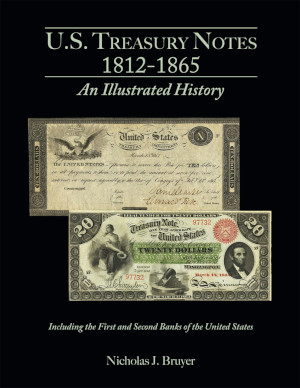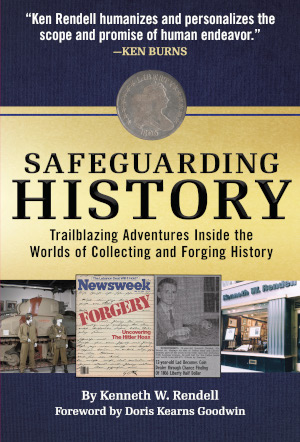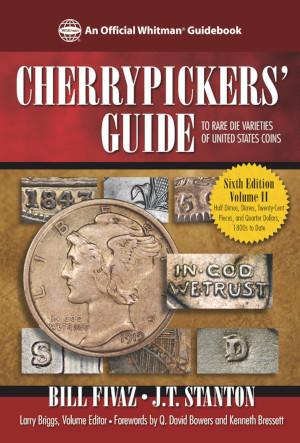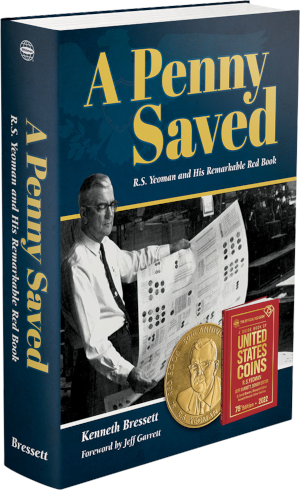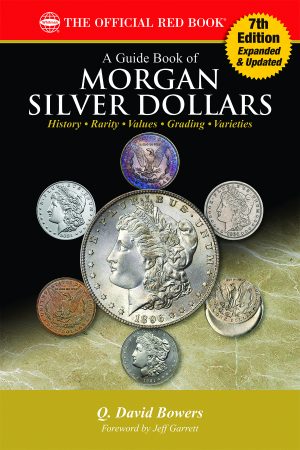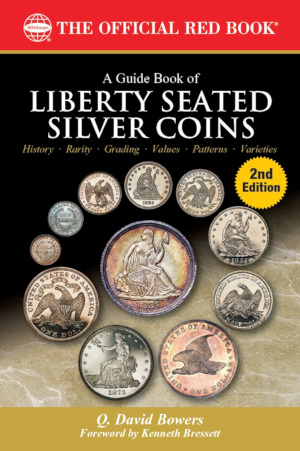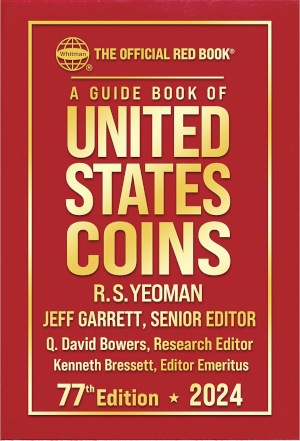The seventh edition of Whitman Publishing’s best-selling Guide Book of Morgan Silver Dollars, by Q. David Bowers, is on sale now, available from booksellers and hobby shops nationwide. Here, Whitman publisher Dennis Tucker discusses the new volume in the context of the hobby’s fascination with these historic coins.
Ask collectors to rank the coins of the United States by popularity, and the famous Morgan silver dollar will always emerge at the top of the list. At Whitman Publishing we’re immersed in the coin’s universal appeal. Hobbyists buy thousands and thousands of albums, folders, and other holders to store and display their Morgan dollars. We get emails, letters, and phone calls about the hefty old coins. At coin shows, collectors, dealers, and investors are always talking about them. As we work on each year’s edition of the Guide Book of United States Coins (the “Red Book”), we hear plenty of Morgan dollar observations and market analysis from coin dealers around the country.
Meanwhile, outside the active hobby community, this is one of the “rare coins” that even non-collectors know about. They see them tossed in the air in a Hollywood Western, or for sale in a magazine ad, or nestled in Grandma’s purse. If Grandpa had a cigar box of old money, it likely included a Morgan dollar. Once this coin entered the American consciousness nearly 150 years ago, it never left. It’s a hard-money classic that sparks our imagination.
Given this widespread interest, it’s easy for a publisher to answer the question, “Why make yet another book about Morgan dollars?” In my opinion, America’s most popular coin deserves as many good books as the hobby community can read and enjoy. From observing the book market over the past 20-plus years, I believe that a rising tide lifts all ships when it comes to Morgan dollars. Because of the hobby’s longstanding interest in these coins, each new Morgan dollar book starts out with the potential of a built-in audience. If the book is fun to read and gives valuable information, it will create even more excitement around its already popular subject.
It’s kind of like the Treasury Department’s sale of its warehoused hoards of Morgan dollars in the 1960s and ’70s. Far from glutting the market and depressing prices, the mountains of coins were eagerly bought up, enthusiasm skyrocketed, and values began to rise.
Dave Bowers Creates a New Best-Seller
Q. David Bowers’s Guide Book of Morgan Silver Dollars, billed as “A Complete History and Price Guide,” is the popular standard reference in the field. The first edition was published almost twenty years ago, in 2004. Of course, by then Bowers was widely recognized as a subject-matter expert (not just for Morgan dollars, but across all aspects of U.S. numismatics). His published work on these coins goes back decades; a short list includes the Comprehensive U.S. Silver Dollar Encyclopedia (1992) and the hugely popular two-volume Silver Dollars and Trade Dollars of the United States: A Complete Encyclopedia (1993), not to mention numerous chapters, essays, and articles published in other books and in hobby newspapers, journals, and magazines.
The second edition of this guide book followed in 2005 with updated pricing and certified-coin population data. A new appendix studied the Morgan dollar patterns of 1878.
In 2007 Whitman published the third edition. By this time the modern renaissance in numismatic publishing was well under way. Black-and-white photographs were no longer acceptable to the hobby community; the third edition was published in full color. Again the book’s coin-by-coin pricing was updated, reflecting the active market, and certified populations captured the latest data. New research was incorporated into the manuscript—Morgan dollars are a popular field of study with frequent new discoveries. We improved the book’s layout and typography to make it as pleasantly readable as possible and easy for the reader to navigate.
The fourth edition came out in 2012. Again fully updated and revised, the new edition added an illustrated appendix of misstruck and error Morgan dollars, showcasing some truly remarkable coins including double strikes and off-centers, along with advice to guide smart purchases.
What did the hobby community think of Morgan dollars at this point? The fourth edition’s updated pricing reflected continuing enthusiasm. Many common dates had increased in retail price by 50 percent or more since the book’s first edition debuted eight years earlier, and rare dates and varieties had doubled—or more—in value. The Morgan dollar remained the King of American Coins.
Other New Morgan Dollar Books
By the time the Guide Book of Morgan Silver Dollars established itself as the coin’s modern standard reference, other Whitman books had joined the party. In late 2009 (with a copyright date of 2010) we published Carson City Morgan Dollars: Featuring the Coins of the GSA Hoard, by Adam Crum, Selby Ungar, and Jeff Oxman. “This book begins with the accidental discovery of gold in California in 1848,” we announced at its release. “The struggles of adventurers in the Gold Rush . . . the Nevada silver boom of the late 1800s . . . the creation of the Carson City Mint . . . these are some of the rich historical veins that Crum, Ungar, and Oxman mine in Carson City Morgan Dollars.”
Carson City Morgan Dollars was expanded and revised in a second edition released in 2011, then updated to a third edition that debuted at the American Numismatic Association’s National Money Show held in Atlanta in March 2014. Even with its specific focus on a subset of Morgan dollars, there was plenty of new material to enhance the new edition. It was updated with additional historical photographs, revisions from ongoing research, new coin values and certified-coin populations, and fresh market commentary. A fourth edition was published in 2018, expanded by 24 pages with a photographic gallery of the Carson City Mint, a review of other coins minted there, a study of Morgan dollar values in the late 1940s, and other updates and additions.
In November 2012 (copyright date of 2013) Whitman published The Private Sketchbook of George T. Morgan, America’s Silver Dollar Artist, a remarkable new book made in cooperation with the Smithsonian Institution. “Today most collectors know Morgan as the father of this legendary silver coin,” we noted. “Some specialists are familiar with his designs for commemoratives and medals, and his significant work in U.S. pattern coins. But who exactly was George T. Morgan? Karen M. Lee, a curator of the National Numismatic Collection housed at the National Museum of American History, finally answers that intriguing question. Introducing Morgan’s never-before-published personal sketchbook, and with unique access to family photographs and documents, Lee reveals the man behind the coins. The Private Sketchbook of George T. Morgan is an eye-opening immersion into what Lee calls the designer’s ‘life of art and labor.’”
This book, like the others mentioned herein, went on to win literary awards.
Next, in 2014, a new Whitman book was published, authored by Michael “Miles” Standish assisted by the research/writing team of Charles Morgan and Hubert Walker. In Morgan Dollar: America’s Love Affair With a Legendary Coin, various sections discuss the United States during the Morgan dollar era; the anatomy of the coin’s design; a market study going back to 1946; a year-by-year analysis of the series, including Philadelphia, New Orleans, Carson City, Denver, and San Francisco coins; and Morgan dollar Proofs.
An Exciting Development, and a Fast Sellout!
The fifth edition of Bowers’s Guide Book of Morgan Silver Dollars debuted in September 2016. It featured the requisite updated pricing, a useful new index, fresh illustrations, and exciting news of a startling discovery: information never before published, the story of the 1964 Morgan dollar. This made national headlines, stirred up the hobby’s imagination, and got people talking. (Would we expect anything less from the wonderful and legendary Morgan dollar?)
Until the fifth edition of the Guide Book was published, the hobby community was unaware that dies, hubs, and models for a 1964 Morgan dollar exist deep in the vaults of the Philadelphia Mint. We featured a hub for the 1964 Morgan on the cover of the book, with more photographs and details of the bombshell discovery inside. This discovery was announced in late August 2016, and demand for the new book skyrocketed even before it debuted in September, causing a temporary sellout. We ordered thousands of more copies to be shipped from our printer for distribution that October.
In 2019 the sixth edition continued the ongoing exploration, conversation, and fascination with these classic coins. We dramatically expanded our coverage of the 1964 Morgan dollar, and increased the scope of the index (a helpful tool for navigating the book). A new appendix described a serious threat to the hobby: counterfeit coins. And again we updated the coin-by-coin catalog with current pricing and new certified-population data.
The Newest Edition of Bowers
Today Dave Bowers’s Guide Book of Morgan Silver Dollars is in its seventh edition. This latest version has been expanded by 16 pages, to include more (and larger) illustrations of circulated and Mint State grades; a gallery of toned coins; a new appendix on counterfeit Morgan dollars based on the work of retired Coin World editor Beth Deisher; a new appendix on the 1921–2021 anniversary coins; an expanded index; and a completely updated portfolio of date-by-date coin photographs. The pricing and certified-population data in the coin-by-coin chapter was again updated in a snapshot of today’s market.
George T. Morgan’s classic dollar coin continues to capture the imaginations of collectors, investors, dealers, and everyday Americans. Readers of the Guide Book of Morgan Silver Dollars will find much to learn in this new edition of Dave Bowers’s popular study.
